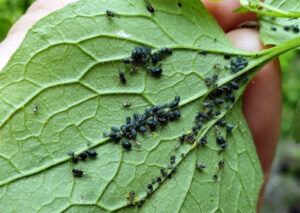Art Kabelowsky, DNR Forest Health outreach and communications specialist
Arthur.Kabelowsky@wisconsin.gov or 608-335-0167

Dozens of garlic mustard aphids feed on the underside of a garlic mustard leaf in Michigan. The small, dark aphids, originally from Europe, have been found in Wisconsin and other states after first being discovered in Ohio in 2021. Photo: Rebecah Troutman, Holden Forests and Gardens, Kirtland, Ohio.
A new tool in the effort to fight invasive garlic mustard appears ready to make its move in Wisconsin.
The garlic mustard aphid, Lipaphis alliariae, has been moving westward after being discovered in Ohio in 2021. Since then, isolated populations have also been found in Wisconsin, Connecticut, Massachusetts, Michigan and Minnesota.
An Ohio State University webcast focusing on the aphids — featuring the biologist who first found the insects in the United States — will offer information on how to identify and report findings, along with details on the insects. The webcast took place on Friday, June 2, and can be found on the webcast’s homepage.
One of the hosts of the webcast, Rebecah Troutman, is a natural areas biologist at Holden Forests and Gardens in the Cleveland suburb of Kirtland. She made the first U.S. discovery of the garlic mustard aphid in 2021 while pulling garlic mustard from a section of the arboretum.
The novel aphids, native to Europe, specialize in eating garlic mustard, Alliaria petolata, a fast-growing invasive plant that is widespread throughout Wisconsin. It’s possible the garlic mustard aphid could become a viable biocontrol agent to fight the spread of garlic mustard.
Garlic mustard, one of the earliest invasive plants to show up each spring, pops up along roadsides, trails and streams, carpets forest floors and tries to take hold wherever its seeds find open ground or disturbed soil. It can often out-compete native plants by crowding them out. Garlic mustard also is able to release chemicals that limit or prevent the growth of other plants (alleopathy).
The plants can grow as tall as four feet in their second year. While garlic mustard leaves carry a telltale garlic odor that many use to flavor salads, soups, meats and sauces, the plant’s relentless growth far exceeds its food value.
Trautman and Midwest Invasive Plant Network (MIPN) coordinator Michelle Beloskur are getting the word out about a website and app where sightings of the garlic mustard aphid can be reported. The information will be used to build a map that pinpoints the locations where the aphids have been found.
Sightings can be reported at the EDDMapS website, or through the downloadable EDDMapS app. Users must register and create a password. Close-up photos are requested. Samples may be packaged and mailed.
More information on reporting garlic mustard aphids is available in this online brochure.
